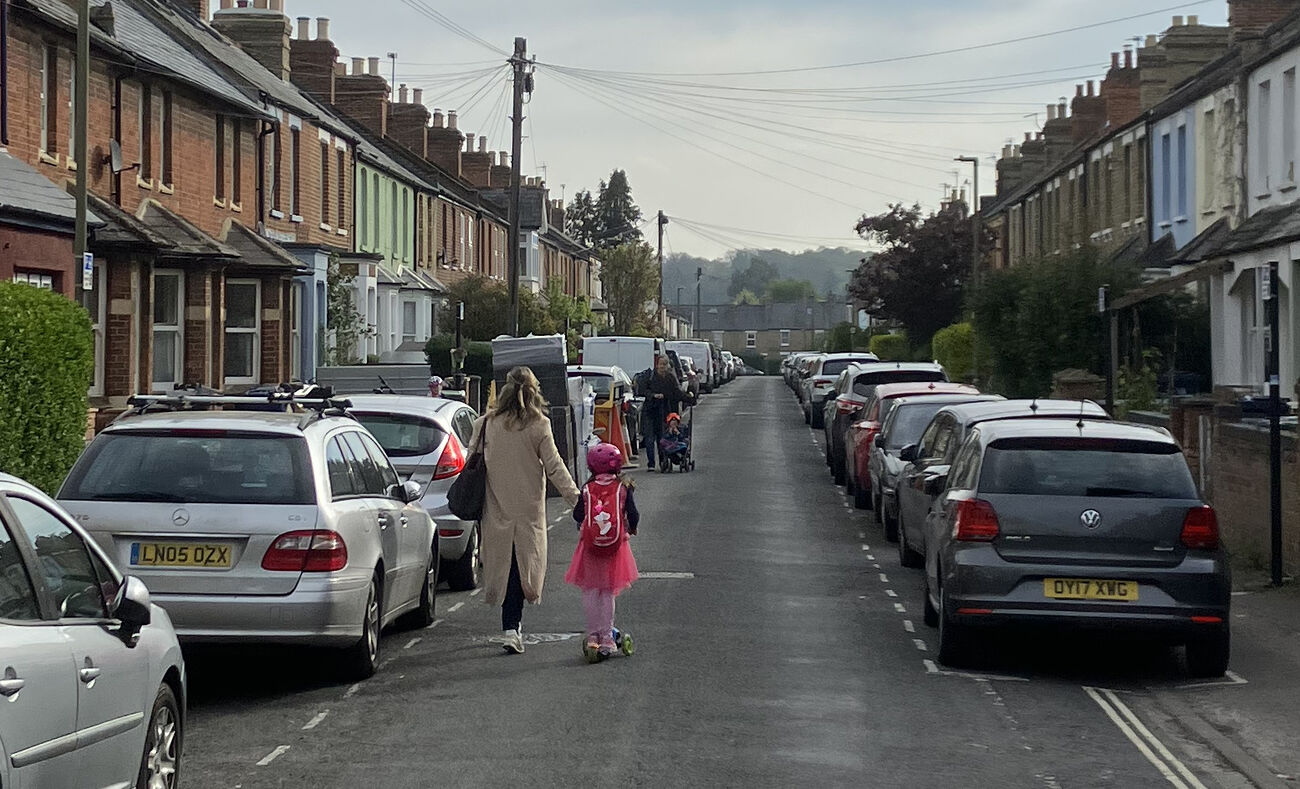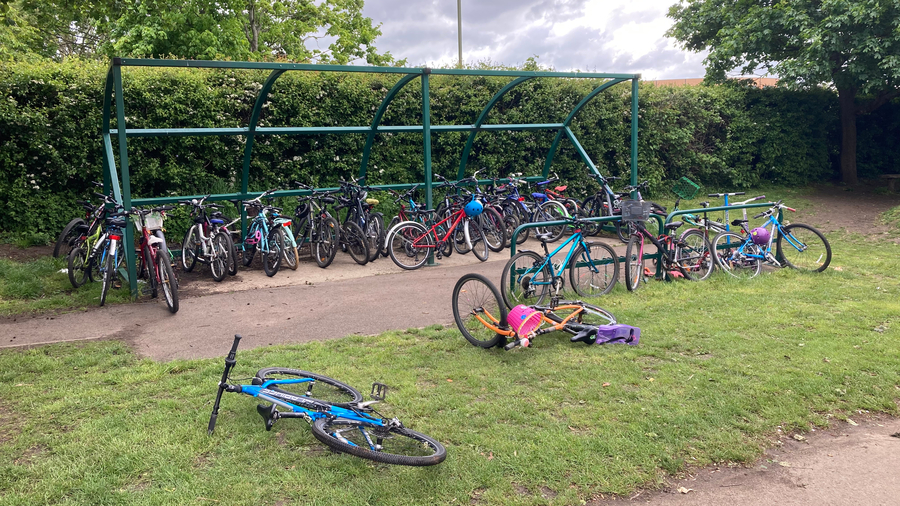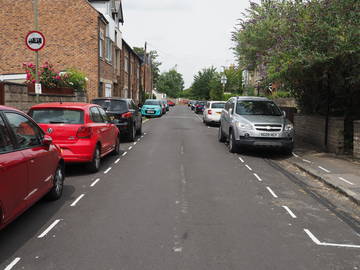No inclusive transport system for Oxford is possible without low traffic neighbourhoods. A genuinely inclusive transport system has to work for everyone. For eight year olds walking or cycling to school by themselves and for four year olds walking or cycling alongside their parents. For eighty year olds who want to be able to walk - or cycle slowly - to their local shops, their GP surgery, or their bus stops, without fear or stress. For wheelchair and mobility scooter users and for the blind and visually impaired. And for everyone else.

Charles St in the East Oxford LTNs, with one mother pushing a child scooting and another pushing a buggy. Car movements are infrequent enough now to make this comfortable. Note that (legal) pavement parking means that neither wheelchairs, mobility scooters, nor larger prams or buggies can fit down the footways.
more
Despite the research, I had always downplayed the psychological and social gains from traffic reduction, thinking of them as secondary to health improvements from increased physical activity - and perhaps as a bit "soft" and hard to measure. But my experience with the East Oxford Low Traffic Neighbourhoods has made me rethink this. more
This an attempt to list all the low traffic neighbourhoods made permanent, or newly introduced, in 2022. It is largely based on information collected by @iambrianjones (Filter more Streets), so is probably London-centric. Let me know if I'm missing anything. more
 Modal shift in action! Seeing individual children at Larkrise taking up cycling or walking is great, but this photo gives a feel for the broader picture. I did a count and there were twenty bikes more than would fit into the school's cycle parking: this rack was eighteen over capacity and the other was two over! (Normal was fewer cycles than spaces.) And it's still happening: there are still people planning cycle training for their children, trying to buy bikes, and so forth. There are also families who have switched from driving to walking, and increasing numbers of older children being allowed to walk to school by themselves. more
Modal shift in action! Seeing individual children at Larkrise taking up cycling or walking is great, but this photo gives a feel for the broader picture. I did a count and there were twenty bikes more than would fit into the school's cycle parking: this rack was eighteen over capacity and the other was two over! (Normal was fewer cycles than spaces.) And it's still happening: there are still people planning cycle training for their children, trying to buy bikes, and so forth. There are also families who have switched from driving to walking, and increasing numbers of older children being allowed to walk to school by themselves. more
Various things have been proposed as alternatives to LTNs. Some of the proposals are complementary to low traffic neighbourhoods rather than alternatives to them. Others rely on technology that doesn't exist, funding that doesn't exist, or are otherwise fantastic. None will achieve the core active travel and liveability goals of a low traffic neighbourhood. more
Consider the junction where the B4495 (Church Cowley Rd) meets the A4158 (Henley Avenue/Rose Hill). Is this the worst junction in Oxford? more
A guest piece by Simon Munk, Senior Infrastructure Campaigner, London Cycling Campaign
Should there be baseline measurement and assessment of LTNs? Hell to the yeah. Will there be? Likely, yes. What should we assess? Overall motor traffic volumes, traffic volumes on peripheral main roads, traffic volumes in adjacent areas, ideally pollution also (but traffic volumes will likely be an incredibly close correlation if not), walking & cycling rates, resident feedback and more. But, wait.... when should we measure? This is really important. IMO measurement of the post-scheme steady state should not happen until at least six months after all schemes are in fully. more
Lower speed limits and speed limit enforcement keep cropping up as an alternative to low traffic neighbourhoods (or to city-wide action to take back space from motor trafic). Traffic calming and lower traffic speeds are an important complement to reducing motor traffic volumes, but not an alternative to doing that. more
I think the biggest gain from controlled parking zones is the prevention of dangerous parking. This can be illustrated by the case of Boundary Brook, in the proposed Donnington CPZ Zone of East Oxford. Vehicles parked here block routes, prevent visibility, and pose a serious risk to the children at Larkrise primary school, as well as to residents and to people who use the area as a walking or cycling route.There are four year olds who cycle to school here with their parents; there are nine year olds who walk here unaccompanied. more
It must have been in 2013 or 2014, when I was still pushing Helen around in a stroller. Coming back from a friend's place on Campbell Rd, I got her safely across Cornwallis Rd at its junction with Rymers Lane, breathed a sigh of relief, and had the idea that a lot of problems would be solved if that junction were simply destroyed — or, to be more accurate, made impassable to motor traffic. At the time this just seemed like a fantasy.
more
One common objection to low traffic neighbourhoods is that reducing motor traffic isn't necessary, and that all we need is traffic calming to stop speeding. But even if traffic calming measures worked perfectly in reducing speeds — which they don't — high volumes of traffic are still a huge deterrent to walking and cycling, and are especially dangerous for children and slower or frailer adults. Traffic calming measures such as chicanes also tend to induce stop-start movements, with rapid speed changes that are dangerous, and force people cycling to repeatedly merge with motor traffic.
As an East Oxford example, consider Cricket Rd and Rymers Lane, which together run 1.3km from Howard St to Between Towns Rd. There are fourteen sets of traffic calming measures here, mostly speed humps combined with chicanes but in a few places just one or the other. more
Oxford already has a lot of low traffic neighbourhoods, without through routes for motor traffic (which is restricted to access). Some of these are "natural", in that they were effectively created by the geography, but new areas of housing are built as low traffic neighbourhoods — no one designs residential streets that will attract through traffic — and others have been retrospectively implemented by modal filters, usually bollards or gates. Here I document some of the latter. more
There is nothing at all complicated about low traffic neighbourhoods, even if urban planners turn them into acronyms ("LTNs") and introduce jargon such as "modal filter". more
The area we're in has recently been made a controlled parking zone, meaning that only vehicles with an area permit can park in it. Residents have to pay £60/year for a permit, with a maximum of two per house, and get a set of one-day vouchers for use by visitors or tradespeople. more



